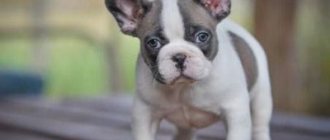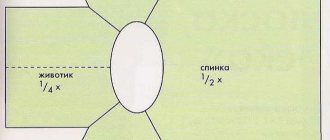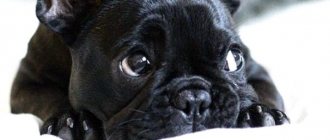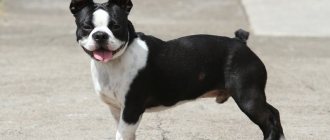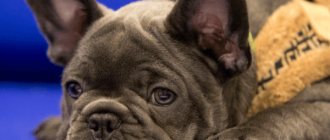The French Bulldog is an extremely popular breed of dog, which is inferior to its larger counterparts solely in size.
Due to their compact size, dogs of this breed do well even in small apartments.
In addition, they are very easy to care for and extremely friendly. However, this breed is not short of willfulness.
From this article you will learn how to properly raise and train French bulldogs so that they are obedient and know how to behave.
Is the breed easy to train?
French bulldogs are very smart and quick-witted. However, this breed is difficult to train. This is due to the character of the “French” - they are headstrong and do not like to obey. Therefore, the problem is not to teach the dog commands, because it easily understands the desire of its owner, but to force it to carry out the order .
Some owners even joke that if you want your dog to follow a command, then repeat it at least forty times, and only then will the Frenchie think about it.
In reality, everything is not so scary. With due persistence on the part of the owner, the French bulldog learns to carry out commands of moderate complexity without any problems. Nevertheless, we must remember that this is a dog not with a service mentality, but with a focus on socialization - in building relationships with the family, it has no equal.
You also need to remember that bulldogs, like people, have their own types of temperaments. For example, a choleric Frenchman quickly becomes distracted during training. Phlegmatic people need to give commands as calmly as possible, without scaring the dog. But sanguine and melancholic people are easy to train, and they even like the process itself.
Advantages of the breed
Among the main advantages of the fighting breed it is worth highlighting:
- strong attachment to the owner;
- friendliness and playfulness (one of the main advantages of the breed);
- ease of training when organizing a variety of activities that the dog will not have time to get bored with;
- no need for long daily walks;
- excellent guard qualities;
- ease of hair care.
The breed has practically no disadvantages, except for their stubbornness, which can be encountered during training, and a tendency to obesity.
Advice! It is best to purchase puppies from a nursery.
The French bulldog is a breed that can be kept not only in a private home, but also in an apartment. The animals are quite smart, cheerful and slightly stubborn. It is difficult to find a similar combination in another breed. Owners of such dogs will never be bored. Bulldogs will run around the house after a ball, delighting their owners with their playfulness and positive attitude.
When should you start learning commands?
You can start teaching your puppy to follow commands from the first month. These include the simplest prohibiting commands, “come to me,” “give me.”
IMPORTANT!
Remember that at such a tender age you need to approach training with care and not put pressure on the dog so that it does not associate training with something scary. A game form is best suited for this.
But serious training should begin at three months. Don't try to master all the commands at once. With proper training, by six months the puppy will know all the basic orders by heart.
Where to begin?
First of all, you need to decide what you want to get as a result - an obedient dog or a bulldog that can perform tricks no worse than four-legged circus performers. Based on this, draw up a detailed strategy for how to raise a puppy.
Whatever choice you make, you should show your French Bulldog who's boss from the very beginning. Being strict in the beginning will save you many obedience problems in the future. The pet also needs to be taught its name.
From the very beginning of your life, teach your puppy to follow simple commands, for example, “come to me,” “fu,” “yes.” Try to do this gently, without causing negative emotions in the baby. The game form is best suited for this.
Also, don't let your dog beg. If you give in just once and share a piece from your plate, your French Bulldog will make the eyes of the world's hungriest dog every time you eat. The dog must not only clearly know its place, but also eat exclusively from its own bowl.
Finally, from the very beginning of education, do not forget about the correct ratio of punishment and reward. Of course, it’s a shame to scold a little puppy when he misbehaves, but this is a forced and necessary measure. Do not let the dog get away with pranks, otherwise in the future this may lead to the dog absolutely not obeying its owner .
Expert opinion
Kozhevin Semyon Kirillovich
Expert dog handler.
The “Frenchie” is not a breed whose training needs to be approached with the utmost rigor. Introduce at least a small element of play into each training session; this will prevent the puppy from getting bored during training, no matter where it takes place - at home or in a special area. There is no need to devote too much time to teaching commands - half an hour a day will be enough for your pet to learn the command without getting too tired. But you need to do this regularly. And most importantly, do not teach your dog to follow commands for treats, otherwise in the future he will only carry them out for a “bribe.”
Bowls and coasters
The puppy is fed in the same place. The volume of the bowl should be slightly larger than the serving and increases with age. The material of the container is durable plastic, ceramics, metal. Glass bowls are not recommended for animals, nor are wooden ones.
In total, two are purchased, one for food, the second for drinking water. They should be washed after every meal.
There is endless debate about the benefits of coasters. If the puppy eats from a bowl on the floor, then nothing bad will happen. The stands are adjustable according to the height of the dog. There are designs for one or more containers. In any case, the bowl is secured so that it does not slide on the floor.
Toilet training
The first rule that an owner needs to remember during toilet training is to be patient!
A small puppy does not always understand his mistakes, so you should not swear too much if the baby makes a puddle in the wrong place. The Frenchman did this not at all out of harm or stupidity.
A puppy should be toilet trained from the age of two months.
Instead of litter box litter, it is better to use absorbent diapers. Newspaper is not suitable for such an intimate matter - lead is harmful even to dogs. Never use cat litter. The baby can swallow it, which will lead to digestive problems.
Be careful where you choose the toilet. It should be quiet, calm and secluded, so that no one distracts the dog from “important matters”.
If you have a large family, then you should not install a dog toilet in the bathroom or toilet room, otherwise it may happen that the dog will not be able to get there when it needs it. Therefore, this puddle will be solely on your conscience!
As soon as you see that the puppy wants to go to the toilet, immediately take him to the litter box. Characteristic signs: the puppy whines and spins in place. Do not over tighten, otherwise a puddle will appear on the floor.
NOTE!
In the event of an “accident,” you need to scold the puppy immediately, because in five minutes he will already forget about his offense.
Remove all carpets from the baby's reach, otherwise there is a high probability that your Frenchie will like to relieve himself in them much more than in the litter box.
Remember that French Bulldogs are extremely clean dogs, so their litter box must be kept perfectly clean.
How to train a French bulldog to toilet outside
Small French bulldogs pee frequently, but it is impossible to train them to toilet before 2 months of age. The puppy will not understand what the owner wants from him.
Here's how to train a French Bulldog to use the litter box: shrink the space where the puppy is used to leaving puddles by laying out newspapers. When adjusting the free space of the floor, direct the animal to where the tray is placed.
Equipping a corner with a tray is a temporary measure; it is used when the pet is small, not vaccinated, or when an adult dog cannot be taken outside after vaccination or illness. An adult vaccinated bulldog needs to be trained to use the toilet outside.
How to train your dog to defecate outside:
- Follow a walking schedule so that the bulldog gets used to the toilet at certain hours.
- Walk with a French bulldog along the same route. When the puppy passes by the place where he peed before, the remaining smell will remind him to relieve himself.
- Praise and pet the bulldog every time he pees on the street.
If the puppy does not want to relieve himself outside, you will have to take him for longer walks and take water and dog food with him. A drunk and full bulldog is more likely to want to pee.
How to teach a puppy to wear a diaper?
The process of teaching a puppy to wear a diaper is no more difficult than training a dog to use the toilet.
To do this, it is enough to meet only four conditions:
- Buy a low litter tray so that your French Bulldog can climb over its sides. Instead of stuffing, put a diaper there. They are both disposable and reusable. During training, do not change the location of the toilet or buy a new tray. Always keep this area clean;
- After the puppy has eaten, immediately take him closer to the diaper. Also remember that your baby will want to go to the toilet immediately after waking up. Do not let him do his “business” on the carpet, as it will be very difficult to wean him off this;
- fence off the space within which the puppy will live. Set up a toilet for him there with a diaper. This way you will make the task easier for yourself, because you won’t have to look all over the house for the place where the Frenchie decided to relieve himself;
- clean up the place immediately after the “accident”. In no case should the cleaning product contain ammonia, because this substance is part of the bulldog's urine, and its smell will only attract the dog. Place a rag containing urine on the puppy's diaper or spray it with a special product that attracts the dog.
How to train a puppy?
A puppy cannot concentrate on one action for a long time, so training should be short but frequent.
If your baby is under four months old, the optimal time would be five minutes at a time; as he gets older, increase the time to ten minutes. You need to exercise your dog three to five times a day.
Be patient, do not be lazy to repeat commands (sometimes you will have to do this more than a dozen times). Do not be aggressive towards your puppy and never use physical violence towards her.
Choose a time when your puppy is most alert.
It is not recommended to train after a heavy lunch, as the baby will want to sleep. However, French bulldogs cannot be trained on an empty stomach - an hour and a half to two hours should pass after the last meal.
Gradually make your workouts more difficult. First, teach your dog simple commands (“come to me”, “fu”), and then more complex ones consisting of several simple ones.
Once your dog has mastered several commands, try clicker training (training using a special device that produces clicks). Click, then immediately give your dog a treat. While executing commands, click the clicker. So, over time, the dog will begin to associate the expected behavior with this sound.
IMPORTANT!
Gradually remove treats so that the dog learns to follow the owner's commands without additional reward.
Below we will look at several examples of teaching a French bulldog simple commands:
- To train your dog to follow the “fu” command, do the following: When she begins to chew on something that is not intended for this, lightly hit her on the nose and say “ugh.” After that, give her her toy. Repeat this until the puppy learns what things in the house are meant for his teeth;
- To teach your dog the “sit” command, stand him in front of you and hold a treat in your hands. Give the "sit" order firmly but in a friendly manner and press the French Bulldog's lower body to the floor. Give a treat and praise your baby. Repeat the exercise, however, this time do not help the bulldog.
Thus, we can conclude that you can teach a dog to commands only with the help of patience, a friendly attitude, strictness and a large number of treats.
Puppy training
Raising a puppy must be carried out in several stages. The correct sequence must be followed to bring the dog under control. The main rule is to start training from the moment the puppy moves into a new apartment. The bulldog's innate stubbornness can slow down the learning process. Sometimes you will have to go through one lesson several times. Until about 2 weeks, the mother is the only caregiver for the puppy. She accustoms the baby to food, provides him with warmth and peace.
Being with its mother all the time, the puppy tries to repeat everything that an adult dog does. By the age of one month, the baby is preparing to do what he has learned independently. During this period, the animal’s good learning ability can be seen, it becomes noticeable that it grasps everything on the fly. From 1 to 1.5 months, the puppy begins to have meaningful contact with its brothers and sisters. At this time, he learns discipline, his character and habits are formed.
By 2 months it is already possible to determine what the dog’s behavior will be like as an adult. If a young individual constantly follows its mother and clings to her, then in the future it will be timid, perhaps even cowardly. It will be problematic for such an animal to adapt to the external environment. If a puppy explores its surroundings without fear of losing sight of its mother, it will be a brave, brave and cheerful animal.
When a puppy first gets to a new home, he should be immediately introduced to the household and the new environment. It is necessary to give him time to develop in a residential area, and only then begin to educate him. The good attitude of the owners will help the pet quickly adapt to its new place of residence.
Accustoming to a nickname
The first and most important step at the beginning of the educational process is to accustom the dog to its own name. From the very first days you need to call your pet by its chosen name. When the bulldog begins to respond to his own nickname, you can encourage him with sweets or a kind word. This way the dog will associate its name with pleasant moments, and this is known to be a useful skill in training. When calling a dog, you need to gradually add a new command to the name: to me.
Place for a pet
The next step is getting used to your own place. It is necessary to first provide your pet with a personal space where he can rest, sleep and chew on his personal toys. You need to start training—accustoming to a place—from the moment the puppy gets to its new home. Pointing to the designated corner, you should pronounce the word for the bulldog: place. This way he will understand and learn the new command faster.
How to toilet train
In order for your dog to relieve himself at home, it is worth training him to carry out the “toilet” command. You will have to identify and show the animal the place where you can defecate. If the puppy begins to go to the toilet past the designated place, you should strictly and seriously voice the word “no”. Also, this command should be prohibited from doing something in the future once and for all. There should be no situations where a certain action is either prohibited, ignored, or encouraged - the animal will not understand and will act at its own discretion.
You should not hit the puppy or shout if he was unable to go to the toilet at his destination. You need to be patient and take him to the tray when he passes by to relieve himself. When the dog manages to go to the toilet as it should, be sure to praise it and give it a treat.
It is worth considering that during puberty, a dog may experience a failure. The habit of going to the litter box when needed may disappear, and the dog will begin to mark wherever it comes into his head. There is no point in beating or scolding a Frenchman. You'll just have to start toilet training from the very beginning.
Basic commands
The third period is the socialization of the dog. This stage occurs when the puppy is between 2 and 4 months old. At this time he is very active and inquisitive. The young bulldog is interested in everything that happens around him. At this stage, the owner’s task is to help and guide the pet in the right direction. This age is also the most optimal for starting serious training. Training and education must begin at home in a playful way.
At this age it is very easy to teach a dog basic skills:
- place;
- near;
- to me;
- give me your paw.
Commands learned at an early age will serve you well in the future when you need to:
- take hygiene measures (cut nails, clean eyes or ears);
- go to the veterinarian;
- take part in competitions or exhibitions.
Places for resting and toileting, as well as for feeding, should be determined for your pet. It is necessary to accustom your dog to a diet using the word “eat”. Meal times should be determined initially. The established regime should always be strictly followed. You need to feed your dog only suitable foods - food from the human table is completely unsuitable. You should not make concessions and give your pet food at the wrong time. Just one time (unscheduled feeding) is enough and the Frenchman will begin to constantly beg from the person. Another important command that needs to be learned from an early age is fu. This word will henceforth mean a prohibition of any action that might at another time be permitted.
You cannot conduct a new lesson until previous commands are reinforced. Each new workout should begin by repeating the previously completed stages. Sometimes you can (and should) scold your pet - when it deliberately runs away from its owner or ignores his commands. A stern voice or a menacing shout will be enough for a peace-loving Frenchman. The main thing is for him to understand the pattern between the action taken and the person’s reaction.
Consistency, monotony and repetition will promote dog obedience. If the commands are strictly followed, you can give the dog a treat, but you should not get too carried away. A couple of bites of goodies will do as praise.
A kind attitude and constant encouragement should not be complemented by familiarity. By keeping a distance, the owner will be able to maintain the lead. Otherwise, the dog may challenge the right to dominance.
If your pet starts to growl or bite, you should reconsider your parenting tactics. Most likely, he has already started trying to dominate. You need to communicate more strictly with the animal, but do not engage in assault - the dog will grow embittered or completely stop reacting to the owner.
If your dog has become aggressive, you can try the solitary method. The bottom line is that bulldogs are humane and do not tolerate separation from their owner well. You need to leave the dog at home for a while, during which time he will get bored. And then, with the appearance of the owner, anger will be replaced by adoration. Instead of a roar, the owner will encounter caresses and love.
Basic commands in street conditions
From 4 to 6 months, the puppy can begin to be trained outdoors. You need to train him:
- Relieve yourself in new conditions. The familiar word “toilet” is suitable for this.
- Obey unquestioningly, especially when prohibited. For example, a bulldog wanted to approach a stranger's dog. When the command fu is given, the pet must stop moving towards the other animal. In another situation (when no fu is commanded), you can meet or smell another dog.
- Monitor the actions and commands of your owner. At first, extraneous movements and noises may distract the animal. When a lot of interesting things are happening around, it is quite difficult for a curious and slightly lazy dog to concentrate on completing human tasks.
Complete obedience will help in some situations to save the life of a Frenchman - when he decides to chase a cat or cross the road in front of a nearby vehicle.
When the dog gets comfortable in outdoor conditions, you can take him to a special area for dogs. So you should continue training, asking new commands: fetch, stick, barrier. Physical exercise (running up stairs, parallel bars, jumping over bars) will have a good effect on both your pet’s health and his psyche.
In addition, it is necessary to train the animal to refuse food that is laid out on the street. You should also warn your pet against eating food from strangers. Obedience and good manners, following the owner, unquestioning execution of commands - all this should be developed in a dog by the age of 1 year.
In-depth training
If there is a need to raise an angry dog, you need to enroll your pet for training in a kennel club. After all, first of all, an aggressive dog is intended to protect the entrusted property or territory from intruders. Some individuals begin to beat and starve the dog, believing that without any help it will become evil. But, as you know, any wrong action can disrupt the animal’s psyche. In this case, the bulldog's aggression will be directed at the owner himself, and not at protecting him from strangers.
If there is no desire or opportunity to give the dog to professional dog handlers, then it is worth getting their recommendations. Telephone numbers of specialists will also be needed if the dog cannot remember simple commands for a long period of time or has become uncontrollable.
Dog behavior on the street
First of all, the pet must be accustomed to a harness, leash and other accessories for walking. Read how to do this here.
The French bulldog is an extremely peace-loving creature, and also has small dimensions, so it is not difficult to accustom the “Frenchie” to decent behavior.
You just need to follow a number of recommendations:
- walk at a calm, measured pace, do not adjust to your pet if he decides to take an unplanned walk. Ideally, the dog should know the command “near”;
- If the bulldog starts to pull the leash towards itself, then just stop. Ignore his attempts to pull you along with him;
- When your dog looks back at you, praise him. If this happens several times during one walk, then give him a treat. This is called "leash training";
- Like any other pet, the French bulldog is prone to picking up all kinds of garbage from the ground. To wean him off this, learn the “fu” command;
- do not interfere with the socialization of the dog, if it wants to communicate with another pet, then do not interfere with this if the “new friend” is friendly;
- The French bulldog is not prone to aggression, but sometimes it can be overly friendly. Learn the “place” command to stop your dog the moment he wants to interact with a stranger. Remember that someone may be afraid of such a baby, and besides, some people can easily offend even a dog that is peaceful towards them.
Basic training methods
A training method is a method of influencing a dog, the task of which is to develop in it the skills necessary for a trainer.
To train French bulldogs, two types of training are most often used - taste-based and mechanical methods.
They are the calmest and do not cause negative emotions in the dog in the process.
Let's look at each of them step by step.
Taste-based training method:
- stock up on your pet’s favorite treats (human food should absolutely not be used as a reward!);
- start training three to four hours after feeding;
- give the dog a command;
- repeat it until the bulldog does it correctly;
- give him a treat;
- repeat this process until reinforced, following the principle: correct execution of the command is a treat.
Mechanical training method:
- put the dog in front of you and give it a command;
- if she performed it correctly, then stroke her or scratch her behind the ear;
- Use mechanical rewards every time your dog obeys you.
CAREFULLY!
It is worth noting that in the case of French bulldogs, a forced training method cannot be used. Your pet will be afraid of you and, instead of following commands, will try to either move away or hide.


